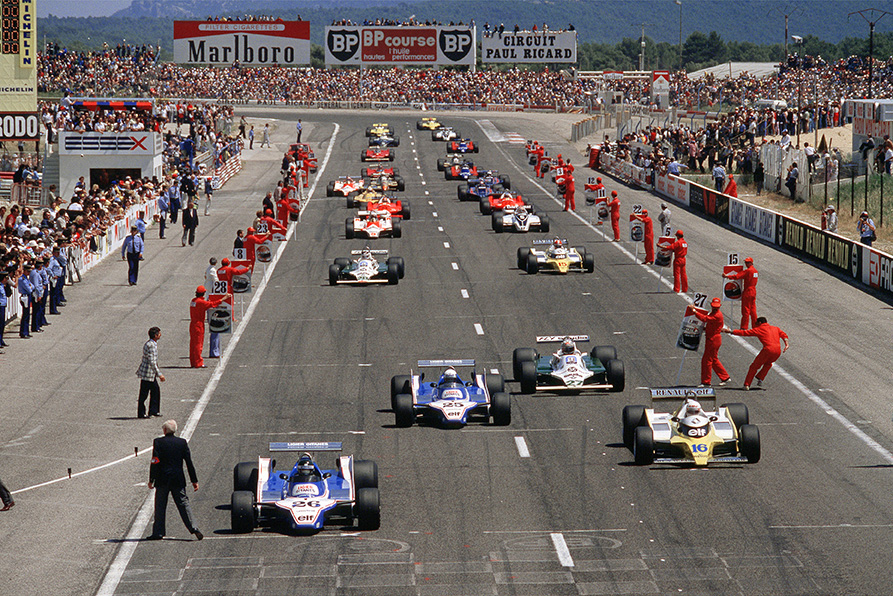
The Ligier JS11/15, a glorious past
At the 12th Monaco Historic Grand Prix at the end of April, the Ligier JS11/15 made a successful return when it found itself pitted against some of its prestigious rivals from over 40 years earlier like Lotus, Tyrrell, Williams, Arrows, etc. It was a way to revive the glorious past of the most titled of the F1 Ligiers. In 1980, the JS11/15 driven by Jacques Laffite and Didier Pironi helped the small French make to achieve its highest place in the F1 Constructors' Championship with a thoroughly-deserved second position.
In 1980, the ground-effect F1s were at their peak. This aerodynamic system glued the cars to the track in the bends helping them to reach mind-blowing speeds. At the time the majority of cars, the JS11/15 included, adopted it and integrated a system of skirts under the car. While the Ligier used the monocoque of the previous model, the JS11, created the year before by Gérard Ducarouge and Michel Beaujon, the two engineers fine-tuned the car even further. It was still powered by the V8 Ford Cosworth DFV engine and shod with Goodyear tyres.
At the wheel were two French drivers, one as fiery as the other, Jacques Laffite in #26 and Didier Pironi in #25. The season got off to a bad start with two retirements in Argentina due to engine problems. Hope sprang afresh in the South African Grand Prix with Ligier back on the podium as Laffite was on the second step and Pironi on the third. However, the team had to wait for its return to Europe to score its first win of the season in the Belgian Grand Prix in which Pironi drove the JS11/15 to victory clinching his maiden F1 win in the process. Monaco was a slight disappointment even though Laffite finished second as Pironi was running away with the race until he hit the guardrail and had to retire.
The Bleus put this behind them and got down to preparing for the French Grand Prix at Le Castellet. “It's the race you absolutely want to win,” says Laffite, “and the one for which I still have the most regrets! Who was at fault? A lack of coordination between the engineers, wrong tyre choice, a tense atmosphere between Guy and Didier who was going to sign for Ferrari, which drove Ligier absolutely crazy?” Once again the French team had to be content with second and third places, still the best result scored by Ligier in the French Grand Prix.
In the German Grand Prix at Hockenheim Laffite was on the topmost step of the podium, but it isn't a great memory for him as Patrick Depailler had been killed in preliminary practice. After Germany, the two drivers scored only a further three third places. Pironi jumped the start in the Canadian Grand Prix and even though he wasn't alone, he was the only driver to be given a penalty which robbed him of victory. Unfortunately, 10 podiums including two victories weren't enough to make Les Bleus' dream come true. Ligier finished second in the Constructors' Championship with the JS11/15 behind Williams, but in front of Brabham. It was a brilliant result for a little team that personified France throughout the whole world.
“We could have and should have won,” regrets Laffite. “We missed opportunities even though we were a good team. Ducarouge was very cunning and that's what you had to be in Formula 1 at the time! Especially when you didn't have a huge budget. There were barely 15 people per car. We had a really great racer. Didier who I liked very much and I had a lot of scraps. He was a very good team-mate, very intelligent and he was also very quick. He raised the bar very high!”
In 1981, at the same time as the Ligier JS11/15 ceded its place to the JS17, the era of the all-dominant wing cars with their ground effect was coming to an end; they gradually became outclassed by cars with powerful turbo engines encouraged by the anti-skirt regulations. The budgets required were no longer the same and it was the end of the era of small teams and artisan constructors.
Ligier launched itself into the fray the following year by teaming up with Talbot and Matra.